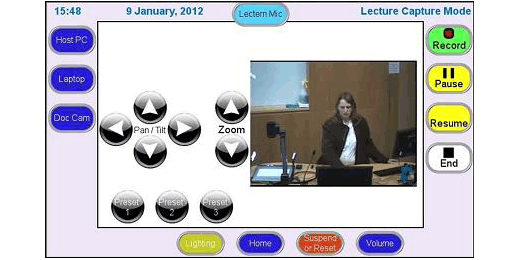
September 26, 2012, by Teaching at Nottingham
Audio-visual recordings and student learning
Dr Joel Feinstein & Claire Chambers: “Classes have become more interactive and there are new ways of supporting students with extra online resources, which they can access after class. We’ve run workshops for staff to help those with less experience to produce high quality videos. Staff from the Audio Visual unit (within the IS Learning Team) have helped with advice and practical support about vodcasting, lecture capture, field work videos and video diaries, amongst other things.”
What is available?
“Currently we have a range of equipment available to staff, including an assortment of cameras, tripods, webcams and wireless microphones – staff can choose what they need depending on their activity. We also have two iPads which are easy to use, portable, have high quality software, and are available for anyone who wants to try one out in their presentations. Screen video capture software, such as Camtasia has been licenced to over 60 devices. We have also purchased the more user-friendly Echo360 Personal Capture licences which means that you can record and move equipment around easily.”
How are we using it?
Presenting
“IT has been used generally in class for years, think about the use of PowerPoint slides, for example. Now, with the introduction of tablet PCs we can annotate these slides by actually writing on the tablet. We have also seen the use of video demonstrations in class where you can bring the big bang universe into the classroom, in a way that is somewhat difficult with a whiteboard and pen. We have also seen how distance learning live can encompass interactive tutorials and teaching environments. In mathematical science we have used the Elluminate [now Blackboard Collaborate] virtual teaching room, which has a shared whiteboard and audio connection.”
Supporting materials
“We can make annotated slides and audio and/or visual recordings available online for students after lectures. There are many variations on the kind of materials we can make available, but some ideas have included a run through of solutions on a little video or providing tutorial materials online. Then, rather than direct videos, there are various interactive learning resources which allow students to really get stuck in. This interactivity could also form a complete course and resources for distance learning.”
Student response
“Students have told us how useful they find the extra resources, saying ‘make more available’, ‘we’re really grateful for everything you give us’ and ‘here are the ways these resources help us’. Students have also been involved in producing their own materials for their courses, such as recording field trips. The technology is well appreciated, but we must be cautious to balance our gains and losses in moving forward, as we need to keep an eye on the effects it has on student learning.”
Summary
“Media and technology can be used as an extra tool to help student learning, and is often cheap and easy to use. This blog post started as Joel’s Project overview presentation. A partial transcript was published in the project booklet http://www.mathstore.ac.uk/headocs/METALbooklet.pdf which is structured by the use of technology and questions the use of recordings and their effectiveness in student learning in further detail. This blog post is adapted from that partial trasncript.”
Associated links
Joel’s page about the project on his Explaining Maths blog:
http://explainingmaths.wordpress.com/media-enhanced-teaching-and-learning-metal-workshops-at-nottingham/
Recordings from the METAL workshops on Workspace at:
https://workspace.nottingham.ac.uk/display/METAL/Past+events (UoN staff login only)
Student Feedback
A student from the Vet school discusses her use of lecture capture:
http://wirksworthii.nottingham.ac.uk/webcast/IS/Amanda.wmv
Here are some examples of materials produced for students using METAL resources
- http://wirksworthii.nottingham.ac.uk/webcast/maths-dh/G12PMM-02-03-11-L2/G12PMM-02-03-11-L2.html
- http://uilapech01.nottingham.ac.uk:8080/ess/feed?id=96f10203-f115-4b9d-98ce-9f462540c981&type=M4V
- www.youtube.com/Moriarty2112 (Philip Moriarty’s physics channel, including lectures +)
- http://uilapech01.nottingham.ac.uk:8080/ess/echo/presentation/51f3babc-fcab-46dc-b4cc-e680718c7782 (one of Joel’s lectures, UoN only, login required)
Dr Joel Feinstein, School of Mathematical Sciences and
Claire Chambers, School of Geography
METAL (Media Enhanced Teaching and Learning) project
No comments yet, fill out a comment to be the first

Leave a Reply